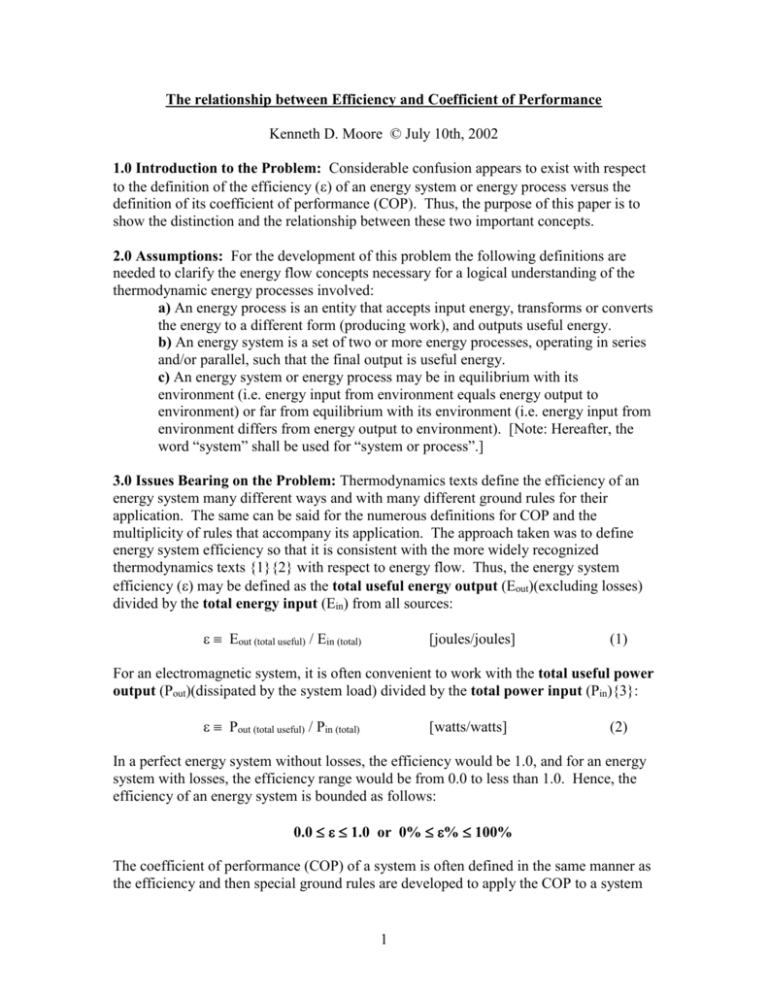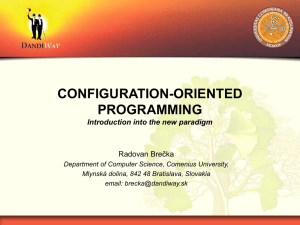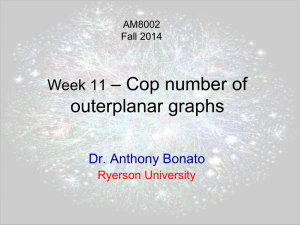The relationship between Efficiency and Coefficient of Performance
advertisement

The relationship between Efficiency and Coefficient of Performance
Kenneth D. Moore © July 10th, 2002
1.0 Introduction to the Problem: Considerable confusion appears to exist with respect
to the definition of the efficiency () of an energy system or energy process versus the
definition of its coefficient of performance (COP). Thus, the purpose of this paper is to
show the distinction and the relationship between these two important concepts.
2.0 Assumptions: For the development of this problem the following definitions are
needed to clarify the energy flow concepts necessary for a logical understanding of the
thermodynamic energy processes involved:
a) An energy process is an entity that accepts input energy, transforms or converts
the energy to a different form (producing work), and outputs useful energy.
b) An energy system is a set of two or more energy processes, operating in series
and/or parallel, such that the final output is useful energy.
c) An energy system or energy process may be in equilibrium with its
environment (i.e. energy input from environment equals energy output to
environment) or far from equilibrium with its environment (i.e. energy input from
environment differs from energy output to environment). [Note: Hereafter, the
word “system” shall be used for “system or process”.]
3.0 Issues Bearing on the Problem: Thermodynamics texts define the efficiency of an
energy system many different ways and with many different ground rules for their
application. The same can be said for the numerous definitions for COP and the
multiplicity of rules that accompany its application. The approach taken was to define
energy system efficiency so that it is consistent with the more widely recognized
thermodynamics texts {1}{2} with respect to energy flow. Thus, the energy system
efficiency () may be defined as the total useful energy output (Eout)(excluding losses)
divided by the total energy input (Ein) from all sources:
Eout (total useful) / Ein (total)
[joules/joules]
(1)
For an electromagnetic system, it is often convenient to work with the total useful power
output (Pout)(dissipated by the system load) divided by the total power input (Pin){3}:
Pout (total useful) / Pin (total)
[watts/watts]
(2)
In a perfect energy system without losses, the efficiency would be 1.0, and for an energy
system with losses, the efficiency range would be from 0.0 to less than 1.0. Hence, the
efficiency of an energy system is bounded as follows:
0.0 1.0 or 0% % 100%
The coefficient of performance (COP) of a system is often defined in the same manner as
the efficiency and then special ground rules are developed to apply the COP to a system
1
{4}. If the relationship between efficiency and COP is to be clarified, the definition of
COP should be different from that of efficiency. It is submitted that the purpose of
having a COP is to provide a relative indicator that shall evaluate the performance of
each system in terms of the energy input by the user or operator and the useful energy
output generated by the system. This leads to a relationship proposed by Bearden, where
the total useful energy output is divided by the total input energy that the operator
must supply in order to make the system function properly {5}{6}. Thus,
COP Eout (total useful) / Ein (operator)
[joules/joules],
(3)
COP Pout (total useful) / Pin (operator)
[watts/watts].
(4)
and
It is noted that for certain systems, the operator input during system operation can be
zero, and yet the system continues to produce useful output energy or power dissipation.
For example, a windmill, waterwheel or sailboat would be examples of such systems, and
it is clear that the environment in which the system is operating supplies the additional
input energy. It is also clear that for such systems, the COP is infinite, since the
operator’s input is zero. However, the efficiency of these energy systems is bounded
between zero and one, which suggests that Ein (total) from equation (1) must have an
additional component other than Ein (operator). Otherwise, the efficiency would also be
infinite. Logically, it follows from the empirical evidence (i.e. the windmill, waterwheel
and sailboat) that the environment is the additional source of input energy. Therefore,
Ein (total) = Ein (operator) + Ein (environment),
(5)
and the energy efficiency as shown in equation (1) is more precisely defined as:
Eout (total useful) / [Ein (operator) + Ein (environment)]
(6)
4.0 Discussion: Equation (6) anticipates the possibility that the operator input energy for
a system can be zero, but the efficiency will be less than one due to the inherent losses,
such as shaft friction, aerodynamic drag or hydraulic drag, all of which serve to attenuate
the useful output. These same or analogous arguments apply to electromagnetic systems,
where the environment is the active vacuum or space-time. During the last several years,
physicists such as Anastasovski, Bearden, Evans, et al. from the Alpha Foundation’s
Institute of Advanced Studies (AIAS) have published new physics based upon nonAbelian O(3) electrodynamics, which is a subset of the Sachs unified field theory derived
from the Einstein theory of general relativity {7,8,9}.
To date more than 100 papers have been published by AIAS, which describe a new nonAbelian O(3) electrodynamics that accurately calculates and solves many problems that
the current Abelian U(1) electrodynamics does not solve {10,11,12}. Several of these
AIAS papers show that the vacuum is not an empty void as it is currently modeled, and it
should be modeled as an active and energetic space-time that can be used for energy
exchange with a properly designed electromagnetic system {13,14}. Accordingly, the
efficiency of an electromagnetic energy system can be more precisely defined from
2
equation (2) as follows:
Pout (total useful) / [Pin (operator) + Pin (environment)]
(7)
Then by re-arranging equation (7) and solving for Pout (total useful):
Pout (total useful) = Pin (operator) + Pin (environment)
(8)
Dividing each term by Pin (operator):
Pout (total useful) / Pin (operator) = + Pin (environment) / Pin (operator)
(9)
Substituting from equation (4) and re-arranging terms further defines the COP as:
COP [1 + Pin (environment) / Pin(operator)]
(10)
Equation (10) tells us that the electromagnetic system COP is a function of its efficiency
and the ratio of the environmental input power to the operator input power. If the
operator input power is zero, the COP becomes infinite, as in the examples described
above for a windmill, waterwheel or sailboat. If the environmental input power is zero,
the system COP value equals the system efficiency value, as for an under-unity
electromagnetic system. Equation (10) also shows that an EM system can be over-unity,
where the COP ranges from 1.0 to infinity.
A number of skeptics have argued that COP greater than one is impossible because it is
prohibited by the laws of Thermodynamics, and it constitutes “perpetual motion”. These
objections are invalid for the following reasons:
1) The thermodynamics law quoted (usually the second law) applies to a “closed
system” in equilibrium with its environment, and it does not apply to an “open
system” far from thermodynamic equilibrium with its environment.
Unfortunately, thermodynamics defines a “closed system” as one that is closed
only with respect to mass exchange across the system boundary. Hence, energy
exchange across the boundary of an energy system far from equilibrium also is
permitted in a thermodynamically “closed system”, so long as mass is not
exchanged. Thus, it is evident that the thermodynamic definitions of a closed
system and an open system are not mutually exclusive, which is a significant non
sequitur. These equilibrium and disequilibrium relationships will be clarified
further in the charts and text below.
2) The perpetual motion argument is invalid because it implies the creation of
energy within the system, which has not been claimed, and in fact, the origins of
the energy inputs have been clearly specified. Furthermore, the thermodynamic
definition for a closed system permits energy exchange for a disequilibrium state,
which permits a COP greater than one. Rigorously, the discriminator for COP
greater than one operation is energy exchange in a disequilibrium state.
3
In further regard to the perpetual motion issue, Dr. T. E. Bearden (in an e-mail dated 21
June, 2002, subject: Dr. Tom: Canonical momentum) addressed it as follows:
“A strong rebuttal to the charge of "perpetual motion nonsense" (levied by a
senior Board Member of the actual corporation owning that set of journals) was
what got the second MEG [Motionless Electromagnetic Generator] paper
published in Foundations of Physics Letters. We confronted those gentlemen
with the proven broken symmetry of the charge and the dipole, each of which has
COP = infinity. We also confronted them with the solution to the source charge
problem, which does not exist in classical electrodynamics, and then challenged
them to either present a solution to it in classical electrodynamics (CED) or
accept the fact that CED already accepts total destruction of the conservation of
energy law. The award of the Nobel Prize to Lee and Yang for their broken
symmetry prediction cinched it. If they then objected to COP>1.0, it meant that
they had to exclude from electrodynamics all charges and dipoles. Since all
fields and potentials and their energy come from their source charges, this meant
they would have to exclude all EM fields and potentials — and thus all EM energy.
In short, without COP = infinity of those charges, all electrodynamics models "eat
themselves by swallowing their own tail." So the charge either falsifies
conservation of energy altogether and destroys all electrodynamics, or it clearly
proves that COP>1.0 EM systems are not only possible, but ubiquitous.”
Chart 1 below gives a graphical presentation for solutions to equation (10), using selected
ratios of environmental input power (EIP) to operator input power (OIP).
4
The selected ratios shown in Chart 1 have been expressed as a series of percentages that
indicate the contribution of the environmental input power with respect to the operator
input power. Thus, the curve labeled “400%” means the environment contributed four
parts to one part from the operator, which is held constant at “100%”. For each selected
EIP percentage, the system COP was computed (using equation (10)) for stepped values
of system efficiency (every 10%) from 0% through 100%. The resulting plots show a
family of linear curves, all of which originate at the origin.
Chart 1 above indicates that if the environmental input power is sufficiently large, say
four times (400%) the operator input power (100%), and the system efficiency is 50%,
then the COP would be 2.5, which indicates the achievement of an over-unity system.
The breakpoint for a 50% efficient system would occur when the environmental and
operator inputs were equal, producing a COP of 1.0.
The shaded area just above the system efficiency plot axis, which is bounded by System
COP value 1.0 and System Efficiency values 0.0% and 100.0%, represents the region of
system operation where the laws of Equilibrium Thermodynamics apply (Region 1,
green), and the well-known first and second laws limit the COP and the efficiency to 1.0
or less {1}{2}. The area above Region 1 on Chart 1, where the System COP value is
bounded between 1.0 and 5.0 and the System Efficiency is bounded by the values 0.0%
and 100.0%, defines the region where the laws of Non-Equilibrium (or Disequilibrium)
Thermodynamics apply (Region 2, light blue). In other words in Region 2, the system
has been designed or modified to perform as an open system that is far from
thermodynamic equilibrium with its environment {15(a) – 15(e)}.
System Coefficient of
Performance (COP)
Chart 2 below shows another plot for equation (10) where the EIP has been set to a very
large value, and it follows that a linear relationship remains throughout Regions 1 and 2.
Chart 2. System COP vs System Efficiency for a Selected
Percentage of Environmental Input Power (100E100 %)
1.0E+100
9.0E+99
8.0E+99
Region 2
7.0E+99
6.0E+99
5.0E+99
4.0E+99
3.0E+99
2.0E+99
Region 1
1.0E+99
0.0E+00
0.00
20.00
40.00
60.00
80.00
100.00
System Efficiency (%)
5
At this scale for Chart 2, Region 1 is a very thin rectangle along the System Efficiency
axis, which is drawn to an exaggerated vertical scale to be able to see it.
The implicit assumption for these curves generated by equation (10) and displayed in
Charts 1 and 2 is that the system is stable and linear in the production of its output. It is
well recognized that many systems (especially electromagnetic systems) tend to be nonlinear and may operate in an unstable or partially stable manner. Hence, actual results
obtained may be attenuated due to the non-linear nature of the system being developed
and tested. In this context, these curves may be regarded as the theoretical limits of
actual results obtained.
As noted above the maximum value for the System COP can be infinity, which is
consistent with equation (10) when the operator input energy is zero. Chart 3 below
shows this relationship, which is drawn conceptually and not to scale.
Chart 3. System COP vs System Efficiency
where the Operator Input Power is Zero
System COP
Region 2
Region 1
0
0%
50%
System Efficiency
100%
Chart 3 illustrates the windmill, waterwheel and sailboat type systems described
previously, and as an example, it indicates the impact of using solar cells to power
electronic circuits, e.g. satellite systems. Thus, it also shows the effects on a COP
greater-than-unity system that has been closed-looped, so that all input energy is supplied
by the environment, which in this example would be photon energy from the sun. Chart
3 also indicates the system efficiency must be large enough to overcome inherent system
losses, which explains why the system COP does not reach infinity at 0.0% efficiency. In
a real system, the operator must input enough energy to “prime the pump”, and once this
is accomplished, the operator input is removed and the environment inputs the energy.
6
Clearly, the goal of the system designer is to maximize the system COP by achieving the
highest possible system efficiency and environmental input, while minimizing the
operator input needed to make the system function properly. Finally, the ultimate design
goal is close-loop the system, and thereby achieve a COP of infinity.
5.0 Conclusions: System COP and system efficiency have different and distinct
definitions. In the ideal limit, COP is a linear function of efficiency and the energy (or
power) ratio between the environmental and the operator inputs.
a) The calculated efficiency value is bounded by 0.0 and 1.0 (0% to 100%).
It is defined for the general form as:
Eout (total useful) / [Ein (operator) + Ein (environment)], where E is expressed in
joules.
For electromagnetic systems:
Pout (total useful) / [Pin (operator) + Pin (environment)], where P is expressed in
watts.
b) The calculated COP value is bounded by 0.0 and infinity. It is defined for the
general form as:
COP [1 + Ein (environment) / Ein (operator)] Eout (total useful) / Ein (operator), where
E is expressed in joules.
For electromagnetic systems:
COP [1 + Pin (environment) / Pin (operator)] Pout (total useful) / Pin (operator), where P
is expressed in watts.
c) For a system with a COP in the range of zero to one, the calculated value of
the COP and the efficiency will be equal. This situation is supported by the
equations in paragraph b) above when the environmental input goes to zero.
d) For a system to maintain its performance above unity (i.e. COP greater than
1.0), it must be designed to function as an open system far from equilibrium with
its environment, so that the system shall benefit from a continual input of
environmental energy. This environmental input must be large enough to exceed
the operator input, and it must overcome the effects of a system efficiency that is
expected to be less than one.
e) The ultimate design goal is close-loop the system, so that all input energy is
supplied by the environment and the resulting COP is infinite.
7
f) If the system efficiency and system COP are defined as shown in paragraphs a)
and b) above, the resulting relationship between efficiency and COP (as
illustrated in Charts 1-3) is very useful in furthering a better understanding of the
relationships between under-unity and over-unity systems. In fact, this analysis
strongly suggests that under-unity systems are a very small subset of an
infinite set of over-unity systems, which can be developed through further
research and engineering.
6.0 Acknowledgements: A sincere “thank you” to Dr. T. E. Bearden and to Mr.
Alexander S. Labounsky for their very helpful advice, technical suggestions and edits.
Their comments and viewpoints were extremely valuable in assembling the material,
finding the references and maintaining a logical discourse throughout this paper.
7.0 References:
{1} Gyftopoulos, Elias P. and Gian Paolo Beretta, Thermodynamics: Foundations
and Applications, MacMillan, 1991. This is an elaborate textbook developed over the
years at MIT, providing a rigorous and authoritative exposition of thermodynamics.
{2} Kondepudi, Dilip and Ilya Prigogine, Modern Thermodynamics: From Heat
Engines to Dissipative Structures, Wiley, New York, 1998.
{3} Radovic, Ljubisa R., Title - none, Chapter 4, p. 55 and 57, see website:
http://www.ems.psu.edu/~radovic.
{4} Radovic, Ljubisa R., Title - none, Chapter 4, p. 69, see website:
http://www.ems.psu.edu/~radovic.
{5} Bearden, T. E., Energy from the Vacuum: Concepts and Principles, Chapter 2,
paragraph 2.1.6, 2002 (in press).
{6} Bearden, T.E., Energy from the Vacuum: Concepts and Principles, Appendix 1,
Annotated Glossary of Selected Terms, “Coefficient of Performance”, 2002 (in
press).
{7} Anastasovski, P. K., T. E. Bearden, C. Ciubotariu, W. T. Coffey, L. B. Crowell,
G. J. Evans, Myron W. Evans, R. Flower, S. Jeffers, A. Labounsky, B. Lehnert, M.
Meszaros, P. R. Molnar, J.-P. Vigier, and S. Roy, The New Maxwell Electrodynamic
Equations: New Tools for New Technologies, Journal of New Energy, 4(3), Special
Issue of AIAS papers, Winter 1999. Sixty papers by the Alpha Foundation’s Institute
for Advanced Study, that advance electrodynamics to a non-Abelian, gauge theoretic
higher topology theory in O(3) internal symmetry.
{8} Anastasovski, P. K. T. E. Bearden, C. Ciubotariu, W. T. Coffey, L. B. Crowell,
G. J. Evans, M. W. Evans, R. Flower, S. Jeffers, A. Labounsky, B. Lehnert, M.
8
Mészáros, P. R. Molnár, S. Roy, J.-P. Vigier, Development of the Sachs Theory of
Electrodynamics, Foundations of Physics Letters, 14(6), Dec. 2001, p. 595-600.
{9} Anastasovski, P. K., T. E. Bearden, C. Ciubotariu, W. T. Coffey, L. B. Crowell,
G. J. Evans, M. W. Evans, R. Flower, S. Jeffers, A. Labounsky, B. Lehnert, M.
Mészáros, P. R. Molnár, J.-P. Vigier, S. Roy, Empirical Evidence for Non-Abelian
Electrodynamics and Theoretical Development, Annales de la Fondation Louis de
Broglie, 26 (1), 2001, p. 1-24. There is clear empirical evidence for the fact that
classical electrodynamics is not fully described by the Maxwell-Heaviside equations.
In this paper, the empirical evidence is used to construct a form of classical
electrodynamics, which is more self-consistent and able to account for observations,
where the received Maxwell-Heaviside view fails.
{10} Anastasovski, T. E. Bearden, M. W. Evans, et al., Derivation of O(3)
Electrodynamics from the Einstein-Sachs Theory of General Relativity, Foundation of
Physics Letters, 2002 (in review).
{11} Bearden, T. E. Extracting and Using Electromagnetic Energy from the Active
Vacuum, in M. W. Evans (ed.), Modern Nonlinear Optics, Second Edition, 3 volumes,
Wiley, 2001, Vol. 2, p. 639-698. The 3 volumes comprise a Special Topic issue as
Volume 119, I. Prigogine and S. A. Rice (series eds.), Advances in Chemical
Physics, Wiley, ongoing.
{12} Anastasovski, T. E. Bearden, M. W. Evans, et al., O(3) Electrodynamics from
the Irreducible Representations of the Einstein Group, Foundations of Physics
Letters, 15(2), Apr. 2002, p. 179-187.
{13} Anastasovski, T. E. Bearden, M. W. Evans, et al., The Aharonov-Bohm Effect as
the Basis of Electromagnetic Energy Inherent in the Vacuum, Foundation of Physics
Letters, 2002 (in review).
{14} Anastasovski, P. K., T. E. Bearden, et al, Explanation of the Motionless
Electromagnetic Generator with O(3) Electrodynamics, Foundations of Physics
Letters, 14(1), Feb. 2001, p. 87-94.
{15} Thermodynamics of dissipative systems far from thermodynamic equilibrium:
(a) Prigogine, Ilya, Nonequilibrium Statistical Mechanics, Wiley-Interscience,
New York, 1962;
(b) Kondepudi, D., Thermodynamics: From Heat Engines to Dissipative
Structures, Wiley, Chichester, 1998;
(c) Nicolis, G., Self-Organization in Non-Equilibrium Systems: From Dissipative
Structures to Order through Fluctuations, Wiley, New York, 1977;
(d) Nicolis, G., Physics of far-from-equilibrium systems and self-organization,
Chapter 11, Wiley, New York, 1977;
(e) Davies, Paul, The New Physics, Cambridge University Press, Cambridge,
1989, p. 316-347.
~End~
9




